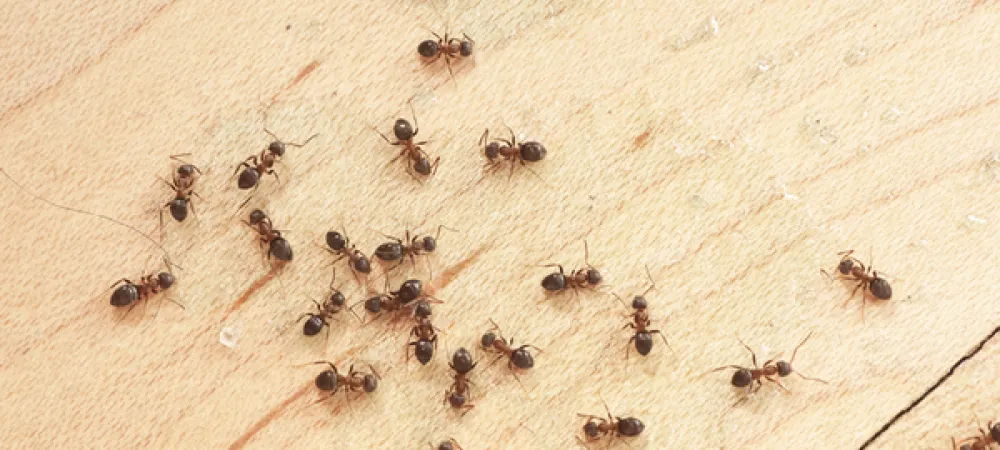Types of Ants in Scottsdale, AZ

Situated within the Sonoran Desert, Scottsdale offers a unique environment that supports a variety of ant life. From bustling urban areas to vast desert landscapes, each habitat harbors its own community of ants, each with distinct characteristics and behaviors.
5 Different Types of Ants in Scottsdale
There are many types of ants in Scottsdale and the rest of Arizona, but here are the 5 most common:
1. Fire Ants
Fire ants are a prevalent species in Scottsdale, Arizona. Identified by their reddish-brown coloration and aggressive behavior, fire ants pose a significant nuisance to residents and wildlife alike. Their sting, which injects venom-containing alkaloids, can cause painful welts and, in severe cases, allergic reactions. Fire ants construct large, mound-shaped nests in open areas such as lawns, parks, and fields, where they fiercely defend their territory. However, their presence underscores the importance of effective pest management strategies to mitigate their impact on both humans and native ecosystems in Scottsdale.

2. Argentine Ants
Argentine ants are a common sight in Scottsdale, Arizona. In Scottsdale, Argentine ants are prevalent due to their adaptability to arid climates and their ability to establish extensive colonies. Unlike some other ant species, Argentine ants do not exhibit aggressive behavior towards other colonies of the same species, allowing them to form supercolonies spanning vast areas. Recognizable by their slender, light brown bodies, Argentine ants are often found foraging for food along trails near buildings, sidewalks, and gardens. While they do not possess a potent sting like fire ants, Argentine ants can become a nuisance when they invade homes in search of food and moisture.

3. Harvester Ants
Harvester ants are a prevalent and integral part of the ecosystem in Scottsdale, Arizona. Thriving in the arid desert environment, these ants are recognizable by their robust build and reddish-brown coloration. Harvester ants are named for their unique foraging behavior, where they collect seeds as their primary food source, contributing to the dispersal of plants in the region. While they are not typically aggressive towards humans, they will vigorously defend their nests if threatened, delivering painful stings with their venomous stingers. Despite their defensive capabilities, harvester ants are essential components of the desert ecosystem in Scottsdale, playing a crucial role in seed dispersal and soil health.
4. Odorous House Ants
Odorous house ants are a prevalent ant species in Scottsdale, Arizona. These ants derive their name from the distinctive, musty odor they emit when crushed, resembling the scent of rotten coconut. Typically dark brown to black in color and relatively small in size, odorous house ants are commonly found invading homes, seeking out sugary substances and protein-rich foods. They often establish nests in wall voids, under floors, and around plumbing fixtures, making them a frequent nuisance for homeowners in Scottsdale. Despite their invasive nature, odorous house ants are not known to cause significant damage to structures and are generally non-aggressive towards humans.

5. Carpenter Ants
Carpenter ants are a common sight in Scottsdale, Arizona, where their presence often raises concerns among homeowners due to their potential for structural damage. Unlike termites, carpenter ants do not consume wood but instead, excavate galleries within decaying or moisture-damaged wood to create nests. These large ants, typically black or reddish-brown in color, prefer nesting in damp or rotting wood found in trees, fences, decks, and even residential structures. In Scottsdale's arid climate, carpenter ants are particularly drawn to areas with water leaks, condensation, or poorly ventilated spaces. Homeowners in Scottsdale should remain vigilant for signs of carpenter ant activity, such as sawdust-like debris, rustling sounds within walls, or sightings of large ants indoors.

What Ants Are Poisonous in Scottsdale?
In Scottsdale, Arizona, there are no native ant species that are considered poisonous to humans in the sense that they produce venom that is harmful if injected through a sting. However, some ants can inflict painful stings or bites, and individuals may experience allergic reactions or discomfort as a result. The two primary ant species known for their stinging capabilities in the region are the red imported fire ant and the harvester ant.
Professional Ant Control Services





